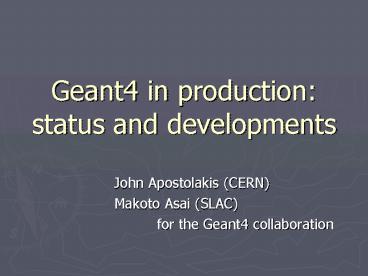Geant4 in production: status and developments - PowerPoint PPT Presentation
1 / 20
Title:
Geant4 in production: status and developments
Description:
brachytherapy, hadrontherapy, Space: satelites and planetary missions ... From revision of electron transport (Multiple scattering) ... – PowerPoint PPT presentation
Number of Views:24
Avg rating:3.0/5.0
Title: Geant4 in production: status and developments
1
Geant4 in production status and developments
- John Apostolakis (CERN)
- Makoto Asai (SLAC)
- for the Geant4 collaboration
2
1. Geant4s in HEP, production
- HEP Experiments in large scale production
- BaBar (2001)
- CMS (2003)
- ATLAS (2004)
- LHCb (2004)
- Used in many existing experiments
- KamLAND, Borexino, HARP,
- Used to study future experiments
- ILC, NA48/3 (PA326),
3
Geant4s widespread use
- Imaging, radiotherapy, dosimetry
- PET and SPECT imaging (GATE),
- brachytherapy, hadrontherapy,
- Space satelites and planetary missions
- XMM, INTEGRAL, Bepe Colombo, LISA,
- Radiation assessment, dosimetry
- LHCb, Electronics (TCAD),
4
2. Geant4 improvements
- Improved stability of EM energy deposition,
resolution - From revision of electron transport (Multiple
scattering) - Enables better accuracy at higher cuts - with
less CPU - Extensions to geometry modeler
- Ability to revise many particle properties
- Refinements, improvements in hadronics
- Physics Lists
5
Summary
- Improvements in multiple scattering process
- Addressing issues with electron transport
- Speedups for initialisation/navigation
- Option to only re-optimise parts that change with
run - New voxelisation options being studied for
regular geometries - Overlap checks at geometry construction
- Revised implementation of particles
- Impacting advanced users, customizing
- Refinements in hadronic physics
6
FLUKA and the Virtual Monte Carlo
- Andreas Morsch
- For the ALICE Offline Group
- CERN, Geneva, Switzerland
Computing in High Energy and Nuclear
Physics 13-17 February 2006, T.I.F.R., Mumbai,
India
7
Integration of FLUKA into detector simulation
frame-work
- Advantages
- Full detector simulation and radiation studies
using the same detailed geometry - Re-use of code for detector response simulation
as already developed for Geant3 - Integration has been achieved using the
- Virtual Monte Interface3 and
- The Root geometry modeler TGeo4
3http//root.cern.ch/root/vmc/VirtualMC.html 4http
//root.cern.ch
8
Virtual MC Concept
- Transport MC transparent to the user application
- Base class TVirtualMC
User Code
VMC
TGeo
Input
GEANT3 VMC
GEANT3
Particles Hits
GEANT4
GEANT4 VMC
FLUKA
FLUKA VMC
Output
9
Virtual Monte Carlo (VMC)
10
Validation
- Validation of geometry navigation via TGeo
- Standard benchmark tests provided by FLUKA
authors - Technical validation of the VMC implementation
- Comparison with G3 results
- Physics validation
- Comparison with test-beam data
11
Electron transport in thin layers
- 1000 electrons at 1 MeV, EM cascades
- Same final random number after simulations with
FLUKA native and TFluka - The same for all 3 tested examples
12
FLUKA/G3 Comparison
- Good agreement where it is expected
- Photons in electromagnetic shower
FLUKA VMC G3 VMC
log10(E/GeV)
13
Comparison with test-beam data ongoing
Silicon Pixel Detector
14
Conclusions
- FLUKA VMC implementation completed
- Testing well advanced
- TGeo/FLUKA validation completed
- Good agreement with G3 and Testbeam
- FLUKA VMC will be used in the next ALICE Physics
data challenge
15
(No Transcript)
16
(No Transcript)
17
(No Transcript)
18
(No Transcript)
19
(No Transcript)
20
Using Linux efficiently !































